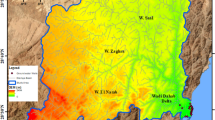Abstract
We derived an equation for saturation in carbonate reservoirs based on the electrical efficiency model in the case of lacking core data. Owing to the complex pore structure and strong heterogeneity in carbonate reservoirs, the relation between electrical efficiency and water porosity is either complex or linear. We proposed an electrical efficiency equation that accounts for the relation between electrical efficiency and water porosity. We also proposed a power-law relation between electrical efficiency and deep-formation resistivity and analyzed the factors controlling the error in the water saturation computations. We concluded that the calculation accuracy of the electrical efficiency is critical to the application of the saturation equation. The saturation equation was applied to the carbonate reservoirs of three wells in Iraq and Indonesia. For relative rock electrical efficiency error below 0.1, the water saturation absolute error is also below 0.1. Therefore, we infer that the proposed saturation equation generally satisfies the evaluation criteria for carbonate reservoirs.
Similar content being viewed by others
References
Archie, G. E., 1942. The electrical resistivity log as an aid in determining some reservoir characteristics: Petroleum Transactions, AIME, 146, 54–62.
Anderson, W. G., 1986. Wettability literature survey - part3: the effects of wettability on the electrical properties of porous media: Journal of Petroleum Technology, 38(12), 1371–1378.
Ali Al G., Roberto, A., and Christopher, R. C., 2011. Cementation exponent estimation for complex carbonate reservoirs using a triple porosity model: SPE/DGS Saudi Arabia Section Technical Symposium and Exhibition, 15–18 May, Al-Khobar, Saudi Arabia, SPE 149104.
Budebes, S., Saif, O., Al-Farisi, O., et al, 2011. Carbonate Archie exponents correction model and variable determination: SPE Reservoir Characterization and Simulation Conference and Exhibition, 9–11 October, Abu Dhabi, UAE, SPE 148377.
Bruce, Z. S., Jeffry, G. H., and Donald, H. C., 2003. Physical model to explain the first Archie relationship and beyond: SPE Annual Technical Conference and Exhibition, 5–8 October, Denver, SPE 84300.
Clavier, C., Coates, G. and Dumanoir, J., 1984. Theoretical and experimental bases for the dual-water model for interpretation of shaly sands: SPE Journal, 24(2), 153–168.
Gao, C. Q., and Tan, T. D., 2000. Identifying types of carbonate reservoir based on electrical conduction efficiency: Acta Petrolei Sinica, 21(5), 32–35.
Gao, C. Q., 2003. Well logging evaluation of complex reservoirs: Petroleum Industry Press, Beijing.
Herrick, D. C., and Kennedy, W. D., 1993. Electrical efficiency: a pore-geometric model for the electrical properties of rocks: SPWLA 34th Annual Logging Symposium, June 13–16, Calgary.
Mahmood Akbar, Jan Steckhan, Masoume Tamimi et al, 2008. Estimating cementation factor (m) for carbonates using borehole images and logs: Abu Dhabi International Petroleum Exhibition and Conference, 3–6 November, Abu Dhabi, UAE, SPE 117786.
Poupon, A., Loy, M. E. and Tixier, M. P., 1954. A contribution to electric log interpretation in shaly sands: Journal of Petroleum Technology, 6(6), 27–34.
Rodolfo, S. B., Digitoil, Cintia Martin, et al, 2012. A new reservoir classification based on pore types improves characterization: SPE Latin America and Caribbean Petroleum Engineering Conference, 16–18 April, Mexico City, Mexico, SPE 152872.
Simandoux, P., 1963. Dielectric measurements on porous media: application to the measurement of water saturation, study of the behavior of argillaceous formations: Revue de L’Institut Francais du Petrole, 18(S1), 193–215.
Waxman, M. H. and Smits, L. J. M., 1968. Electrical conductivities in oil-bearing shaly sands: SPE Journal, 8(2), 107–122.
Zeng, W. C., 1991. Well logging evaluation techniques of oil and gas reservoirs: Petroleum Industry Press, Beijing.
Zhu, J. J., Geng, B., Geng, S. C. et al, 2003. Water saturation explanatory model of argillaceous sandstone under the macroscopically electric conduction mechanism: Petroleum Exploration and Development, 30(4), 75–77.
Author information
Authors and Affiliations
Additional information
This work was partially supported by the National Science and Technology Major Project (2011ZX05030).
Li Xiong-Yan holds a PhD in Engineering from China University of Petroleum (Beijing) in 2011. Now he works in CNOOC Research Institute, engaged in logging information processing and interpretation.
Rights and permissions
About this article
Cite this article
Li, XY., Qin, RB., Liu, CC. et al. Calculation of saturation in carbonate reservoirs based on electrical efficiency. Appl. Geophys. 11, 215–222 (2014). https://doi.org/10.1007/s11770-014-0435-3
Received:
Revised:
Published:
Issue Date:
DOI: https://doi.org/10.1007/s11770-014-0435-3




